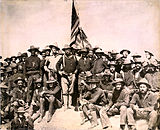John Campbell Greenway
John Campbell Greenway | |
|---|---|
 | |
| Born | 6 July 1872 Huntsville, Alabama |
| Died | 19 January 1926 (aged 53) New York City |
| Allegiance | |
| Service | United States Army |
| Years of service | Brigadier General |
| Battles / wars | World War I *Cambrai |
| Awards | |
| Other work | Mining, steel and railroad executive |
John Campbell Greenway (July 6, 1872 – January 19, 1926) was an American mining, steel and railroad executive. He also had a distinguished career as a soldier, both cavalry and infantry.
Biography
Greenway was born in Huntsville, Alabama, and attended Phillips Academy, Andover and then the University of Virginia and graduated in 1895 from the Sheffield Scientific School of Yale University. His early employment as a furnace helper for the Carnegie Steel Company was brief, as he joined Roosevelt's Rough Riders in the Spanish–American War. After earning a Silver Star for his courageous service at the Battle of San Juan Hill, he was recommended for promotion to brevet captain by Colonel Roosevelt.
Beginning in 1899, Greenway held executive positions in a number of mine, steel, and railroad companies. He supervised development of United States Steel's open pit Canisteo Mine and Trout Lake Washing Plant in Coleraine, Minnesota, one of the first large-scale iron ore benefication plants in the world. Following the successful commissioning of the Trout Lake plant, in 1911 Greenway was recruited by the Calumet and Arizona Mining Company (led by US Steel executives) to develop their newly acquired New Cornelia Mine in Ajo, Arizona. He developed the Ajo townsite and developed the New Cornelia into the first large open pit copper mine in Arizona. Greenway served for one year as a regent of the University of Arizona before the United States entered World War I.
During the war, he was especially praised for his heroic conduct in battle and was cited for bravery at Cambrai. France awarded him the Croix de Guerre, the Legion of Honor, and the Croix de l'Etoile. He also received a Distinguished Service Cross.
In 1919 Greenway became a colonel of the infantry, and three years later he was promoted to brigadier general. John Greenway continued to be active in business until his death in 1926 in New York City.
His widow, Isabella Greenway, served in the U.S. House of Representatives as a Democrat from 1933 to 1937.
In 1930 Arizona placed Greenway's statue in the U.S. Capitol's National Statuary Hall Collection. The statue remained there until being replaced in 2015 by one of Barry Goldwater; the Greenway statue is set to be moved to the Polly Rosenbaum Archives and History Building near the Arizona State Capitol in Phoenix.[1] A statue of Greenway's great great grandfather, Dr. Ephraim McDowell, was placed in the National Statuary Hall in 1929 by Kentucky.
Greenway Road in Phoenix, Arizona, Greenway High School in Phoenix, Greenway Public Schools in Coleraine, Minnesota, and Greenway Township, Itasca County, Minnesota are named in his honor.
References
- Biographical information: National Statuary Hall
- Greenway & Ajo: an article about John Campbell Greenway and Ajo, at the website of the Ajo Copper News.
- Greenway House: an article on Greenway's historic American Craftsman bungalow, which is for sale as of February 2009.
- 2008 removal of a statue of Greenway in Statuary Hall in the US Capitol and its replacement with a statue of Senator Barry Goldwater.
- ^ Theobald, Bill (February 11, 2015). "Goldwater statue dedicated in National Statuary Hall". The Arizona Republic. Phoenix. Retrieved March 1, 2015.
- 1872 births
- 1926 deaths
- American military personnel of the Spanish–American War
- American military personnel of World War I
- University of Virginia alumni
- University of Arizona people
- Recipients of the Silver Star
- Légion d'honneur recipients
- Recipients of the Distinguished Service Cross (United States)
- United States Army generals
- Recipients of the Croix de guerre 1914–1918 (France)
- Yale School of Engineering & Applied Science alumni

